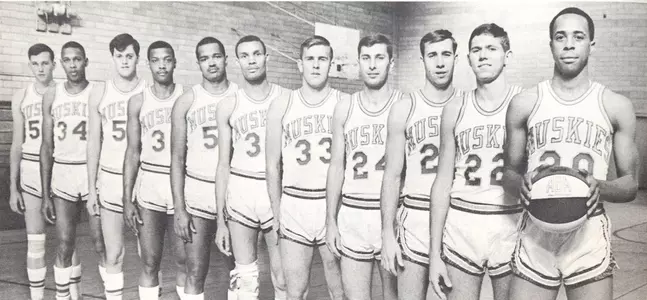University of St. Thomas Athletics

During its lone season, 1967-68, the pro Minnesota Muskies of the American Basketball Association held practices at St. Thomas' O'Shaughnessy Hall in preparation for games held at Met Center in Bloomington.
Throwback Thursday: Pro hoops part of OSH memories
10/22/2020 1:37:00 PM | Athletics
After it opened in the heart of campus in 1939, St. Thomas' O'Shaughnessy Hall enjoyed a lively 70-year run. It created many memories before it was demolished in early 2010 to make way for the Anderson Student Center.
OSH hosted memorable St. Thomas teams and exciting games over the first 40 years when it hosted men's basketball in the old third-floor gym. The Toms moved basketball practices and games into Schoenecker Arena when that facility opened in 1981.
The OSH's six-lane swimming pool was state of the art in the 1940s through 1960s, but the pool's charm faded a bit over the years. Space limits and its overall vintage atmosphere hampered recruiting efforts for Tommie Swim-Dive coaches during the 1990s and 2000s decades.
A second-floor bowling alley helped create a social hub on campus in those early years. But after a near 35-year run, the bowling lanes were closed in 1973 and converted into more recreation space. That area was later converted into a weight room.
There were other grand memories of the O'Shaughnessy Hall space, too. It was a gathering spot for school dances and assemblies. Plus, several touring music acts performed concerts in OSH including John Denver, Louis Armstrong, the Fifth Dimension, Peter, Paul and Mary, the Vogues, Peter Nero, the New Christy Minstrels, and local favorites The Trashmen.
Muskie Fever
The OSH resume included one other unique entry: It hosted practices for a professional basketball team.
The American Basketball Association (ABA) debuted in 1967 as a rival to the established National Basketball Association (NBA). The ABA was headquartered in downtown Minneapolis, and the Minnesota Muskies became one of the 11 charter members.
The Muskies played games in Bloomington, at the since demolished Met Center arena just off Interstate 494.
Surprisingly, whether it was due to our central location or favorable rental fee, the Muskies held practice sessions late mornings on the St. Thomas campus in O'Shaughnessy Hall.
That Muskie team was led by three ABA all-stars:
The Muskies' franchise had big plans for season two with a statewide TV package and nine home games set to played at arenas around the state. But management shifted gears that off season and moved to Florida, changing the franchise name to the Miami Floridians. As an illustration of the franchise's money woes, Mel Daniels was sold to the Indiana Pacers, reportedly for $75,000.
In 1968-69, another ABA team relocated to the Twin Cities from Pittsburgh to become the Minnesota Pipers. That team had future Hall of Famer Connie Hawkins, but after one season in this state that franchise returned to Pittsburgh in 1969.
Minnesota regained a pro hoops team 20 years later with the NBA's expansion Minnesota Timberwolves.
Ironically, a few marquee basketball teams came to campus for solo practice sessions in Schoenecker Arena. The Los Angeles Lakers once used our facility or a trip here to play an exhibition game against the Wolves. And several NCAA Final Four or playoff teams who were in the Twin Cities for tournament play -- including Michigan, Indiana and Michigan State -- worked out in our gym on the day before their games.
The One and Only ABA
Here's a quick summary of the American Basketball Association from the Remembertheaba.com website:
OSH hosted memorable St. Thomas teams and exciting games over the first 40 years when it hosted men's basketball in the old third-floor gym. The Toms moved basketball practices and games into Schoenecker Arena when that facility opened in 1981.
The OSH's six-lane swimming pool was state of the art in the 1940s through 1960s, but the pool's charm faded a bit over the years. Space limits and its overall vintage atmosphere hampered recruiting efforts for Tommie Swim-Dive coaches during the 1990s and 2000s decades.
A second-floor bowling alley helped create a social hub on campus in those early years. But after a near 35-year run, the bowling lanes were closed in 1973 and converted into more recreation space. That area was later converted into a weight room.
There were other grand memories of the O'Shaughnessy Hall space, too. It was a gathering spot for school dances and assemblies. Plus, several touring music acts performed concerts in OSH including John Denver, Louis Armstrong, the Fifth Dimension, Peter, Paul and Mary, the Vogues, Peter Nero, the New Christy Minstrels, and local favorites The Trashmen.
Muskie Fever
The OSH resume included one other unique entry: It hosted practices for a professional basketball team.
The American Basketball Association (ABA) debuted in 1967 as a rival to the established National Basketball Association (NBA). The ABA was headquartered in downtown Minneapolis, and the Minnesota Muskies became one of the 11 charter members.
The Muskies played games in Bloomington, at the since demolished Met Center arena just off Interstate 494.
Surprisingly, whether it was due to our central location or favorable rental fee, the Muskies held practice sessions late mornings on the St. Thomas campus in O'Shaughnessy Hall.
That Muskie team was led by three ABA all-stars:
- Mel Daniels, a 6-foot-9 All-America forward from New Mexico who passed on a first-round draft of the NBA's Cincinnati Royals to sign with the ABA for a $30,000 salary and $15,000 bonus. He averaged 22 points and 16 rebounds with the Muskies en route to ABA Rookie of the Year honors. He later won two ABA Most Valuable Player awards, closed his career in the NBA with the New York Nets, and made the Basketball Hall of Fame.
- Guard Don Freeman, who averaged 28.6 ppg as a senior at Illinois to make the All-America team.
- Center Les "Big Game" Hunter played on an NCAA champion team at Loyola of Chicago, and averaged 18 points and 10 boards with the Muskies.
The Muskies' franchise had big plans for season two with a statewide TV package and nine home games set to played at arenas around the state. But management shifted gears that off season and moved to Florida, changing the franchise name to the Miami Floridians. As an illustration of the franchise's money woes, Mel Daniels was sold to the Indiana Pacers, reportedly for $75,000.
In 1968-69, another ABA team relocated to the Twin Cities from Pittsburgh to become the Minnesota Pipers. That team had future Hall of Famer Connie Hawkins, but after one season in this state that franchise returned to Pittsburgh in 1969.
Minnesota regained a pro hoops team 20 years later with the NBA's expansion Minnesota Timberwolves.
Ironically, a few marquee basketball teams came to campus for solo practice sessions in Schoenecker Arena. The Los Angeles Lakers once used our facility or a trip here to play an exhibition game against the Wolves. And several NCAA Final Four or playoff teams who were in the Twin Cities for tournament play -- including Michigan, Indiana and Michigan State -- worked out in our gym on the day before their games.
The One and Only ABA
Here's a quick summary of the American Basketball Association from the Remembertheaba.com website:
"The ABA existed from 1967 to 1976 -- for nine full seasons. During that time, the ABA fought a bitter war with the established National Basketball Association (the NBA) for players, fans, and media attention. In June 1976, the two rival pro leagues finally made peace. Four of the strongest ABA teams -- the New York Nets, the Denver Nuggets, the Indiana Pacers and San Antonio Spurs -- joined the NBA and survived...
However, the ABA is still vividly remembered by its loyal fans. The ABA was the "outlaw" league with the psychedelic red, white and blue basketball, outlandish promotions and huge afros. It was the "lively" league that adopted the three-point shot -- the exciting "home run" of basketball -- as its own.
The ABA was the "frontier" league that successfully brought (or returned) modern professional basketball to hoops-crazy cities like Indianapolis, San Antonio, Dallas, Salt Lake City, Charlotte/Greensboro, Louisville, Norfolk and Denver. ABA franchises succeeded and even thrived in these locations.
The ABA was also the league without any business sense. The ABA placed unstable franchises in cities like Pittsburgh, Memphis, Miami, San Diego, Washington, D.C., Minneapolis, Houston, Baltimore and Anaheim. For various reasons, these teams struggled to survive. Eventually they disappeared or relocated, leaving their few fans with some strange and indelible memories.
During the course of its existence, the ABA featured dazzling above-the-rim players like Julius ("Dr. J" ) Erving, Connie Hawkins, George ("Ice") Gervin, David Thompson, George McGinnis, Artis Gilmore, Moses Malone, Roger Brown, and Dan "the "Horse") Issel. Each of these electric stars first played professional basketball in the ABA -- with young legs and few limitations. The "frontier spirit" of the ABA also led to a group of memorable characters. The ABA had a coach named "Slick" and players named "Whopper," "Fatty" and "Goo." All of these brilliant ABA artists went on stage in front of notoriously small crowds. Most ABA teams had serious attendance problems and almost no national or local television coverage."
Tommie Athletics Hall of Fame 2025
Monday, October 06
Press Conference: Tommie Football Postgame v Lindenwood 08/28/25
Friday, August 29
Tommie Football Intro Video 2025
Thursday, August 28
Beyond The Buzzer: Schoenecker Arena Setup
Wednesday, July 23












